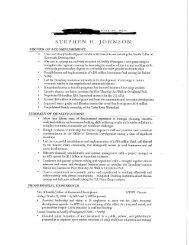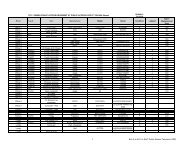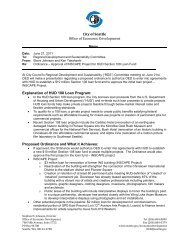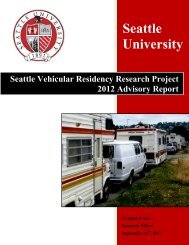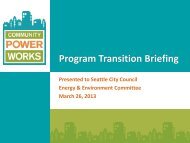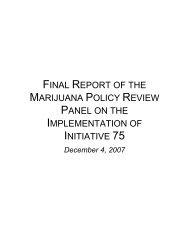2013 Water System Plan, Volume II - Seattle City Clerk's Office - City ...
2013 Water System Plan, Volume II - Seattle City Clerk's Office - City ...
2013 Water System Plan, Volume II - Seattle City Clerk's Office - City ...
You also want an ePaper? Increase the reach of your titles
YUMPU automatically turns print PDFs into web optimized ePapers that Google loves.
coliform, E. Coli, or HPC, and notification to the state. SPU’s Coliform Monitoring <strong>Plan</strong> lists all<br />
sample locations, schedules, test methods used, follow-up sampling requirements, and<br />
notification requirements.<br />
Surface <strong>Water</strong> Treatment Rule (40 CFR 141.70-75 and WAC 246-290 Part 6)<br />
The Surface <strong>Water</strong> Treatment Rule (SWTR) requires a significant amount of monitoring for<br />
SPU’s filtered surface water supply, the South Fork Tolt River. This includes raw water, treated<br />
water, and distribution system water monitoring as follows.<br />
Raw <strong>Water</strong> Monitoring – Continuous monitoring of turbidity at the inlet to the Tolt <strong>Water</strong><br />
Treatment Facility occurs as required by the SWTR. Samples analyzed for fecal coliform<br />
density are collected at the inlet to the Tolt <strong>Water</strong> Treatment Facility daily, for at least 19 days a<br />
month.<br />
Treated <strong>Water</strong> Monitoring – Treated water monitoring for the SWTR consists of monitoring<br />
required to determine the effectiveness of the disinfection process. This includes monitoring to<br />
determine log reduction of Giardia cysts and viruses. To determine the log reduction for virus,<br />
the pH, chlorine residual, temperature, clearwell volume, and peak hourly flow rate must be<br />
recorded. For the Tolt system, this monitoring is continuous, but is reported once a day at peak<br />
hourly flow. To determine the log reduction for Giardia, the pH, ozone residual at multiple<br />
locations along the contact chamber, temperature, and peak hourly flow are recorded. CT is<br />
calculated for each section of the ozone contact chamber. Ct is reported to the state for both the<br />
peak hourly flow and at minimum daily CT.<br />
In addition, continuous chlorine residual monitoring for water entering the distribution system<br />
occurs at the outlet of the Tolt <strong>Water</strong> Treatment Facility. Turbidity is also monitored<br />
continuously at each individual filter unit and from the combined filter effluent.<br />
Additional monitoring is conducted at the treatment plant to meet the requirements of the Service<br />
Agreement with the DBO contractor. This monitoring is summarized in Table 3.<br />
Distribution <strong>System</strong> Monitoring – Residual disinfectant concentration is measured at the same<br />
time and location that a routine or repeat coliform sample is collected within the distribution<br />
system.<br />
Limited Alternative to Filtration (WAC 246-290-691)<br />
Beginning in November 2004, the Cedar water supply system was designated a Limited<br />
Alternative to Filtration status. As such, the source and treated water monitoring requirements<br />
are slightly different than an unfiltered surface water source subject to the SWTR. This includes<br />
raw water, treated water, and distribution system water monitoring as follows.<br />
Raw <strong>Water</strong> Monitoring – Continuous turbidity monitoring occurs at the Cedar <strong>Water</strong> Treatment<br />
Facility for the raw water coming from Lake Youngs (or Landsburg during by-pass operations).<br />
Comprehensive <strong>Water</strong> Quality Monitoring <strong>Plan</strong> Page 3 of 12



